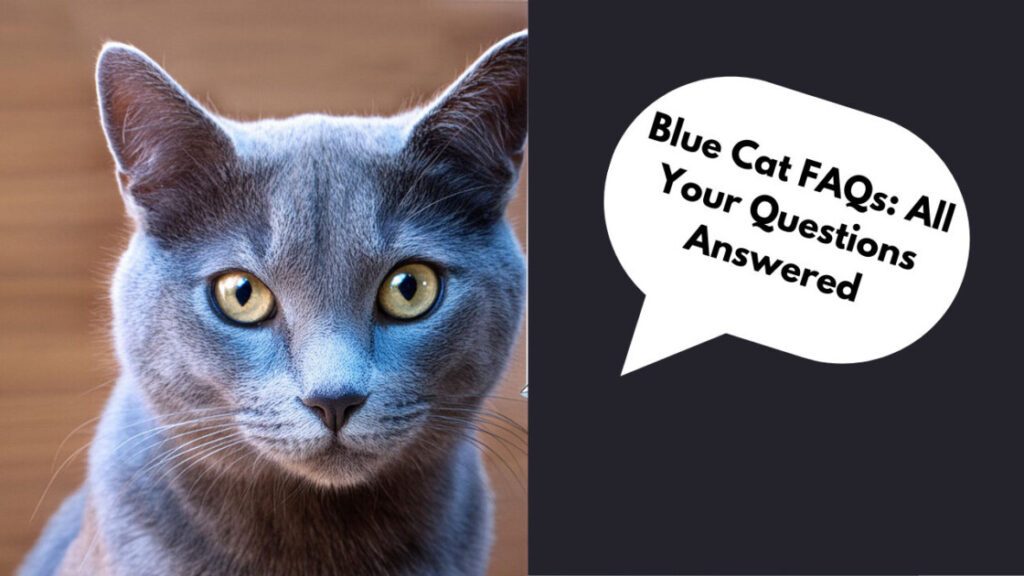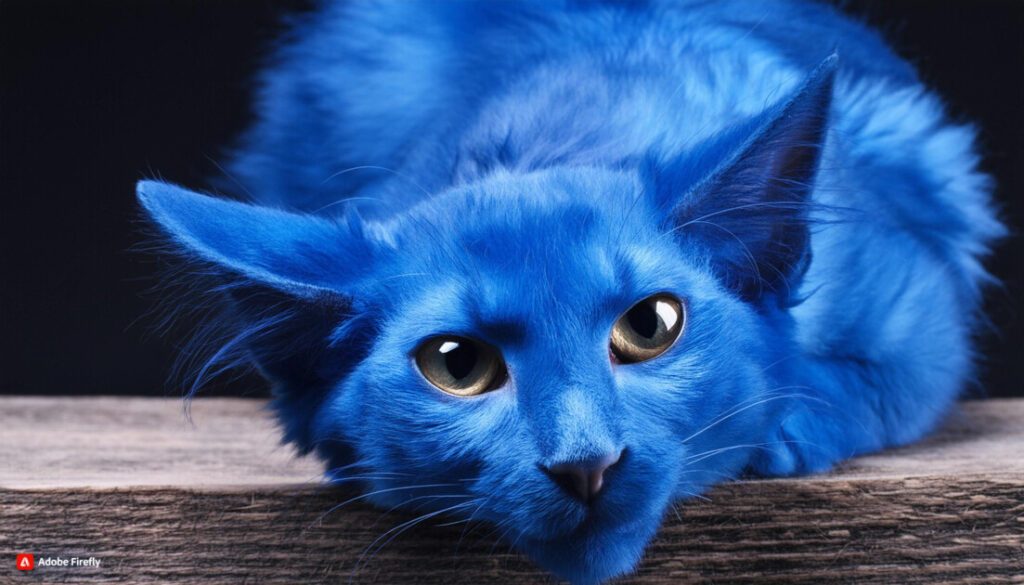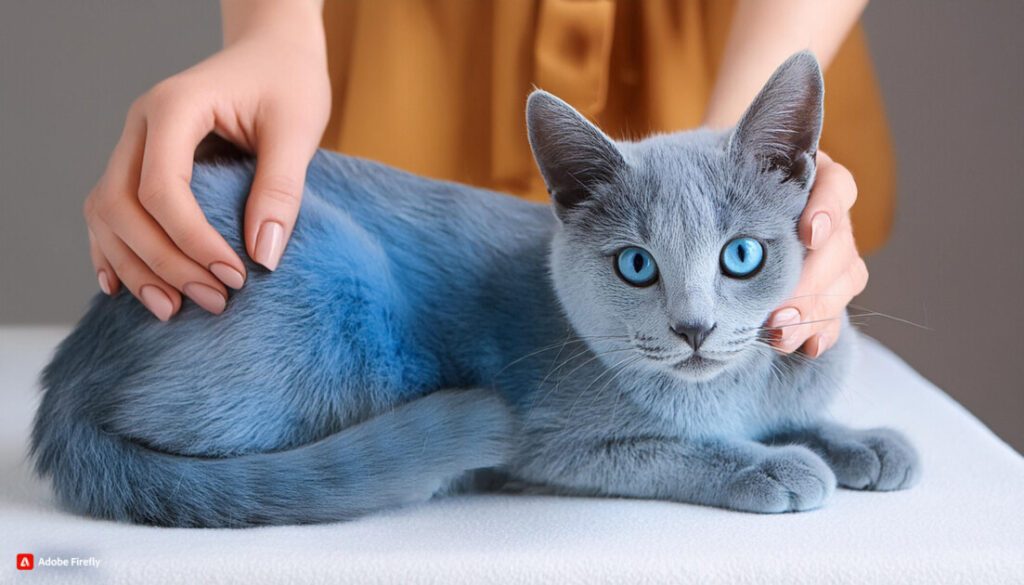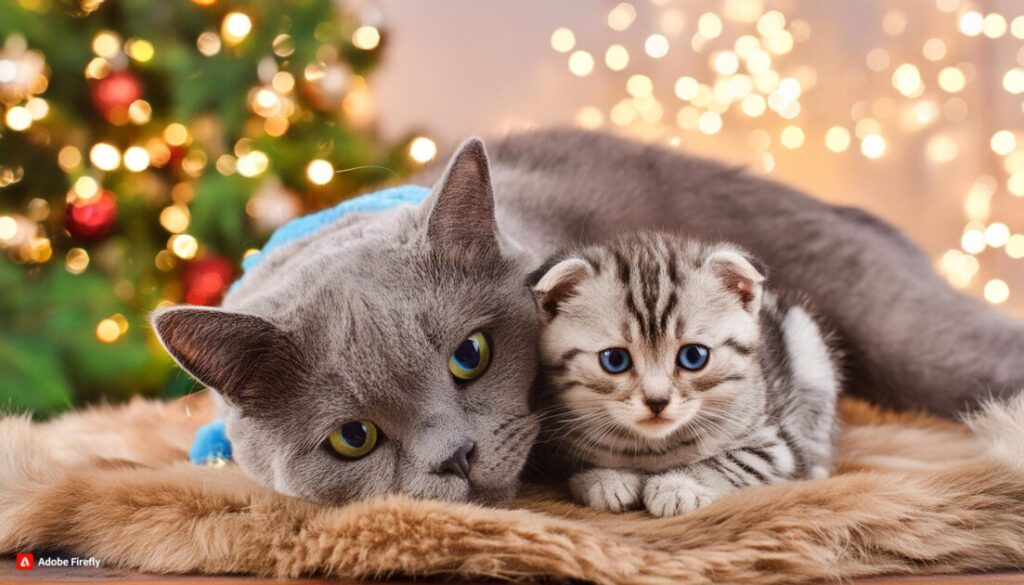Blue Cat | Blue Cat Smurf | Russian Blue Cat for Sale | Blue Cat and Chugs | The captivating world of felines boasts a dazzling array of colours and patterns. Among them, blue cats hold a special place, mesmerizing cat lovers with their mesmerizing coats that resemble the summer sky. This comprehensive guide dives deep into the captivating world of blue cats, exploring their various breeds, unique characteristics, and considerations for bringing one of these charming creatures into your life.

Table of Contents
Beyond the Shades of Blue: A Spectrum of Breeds
While the term “blue cat” might conjure a singular image, the feline world offers a fascinating variety within this colour spectrum. Let’s explore some of the most popular blue cat breeds:
- Russian Blue: Often considered the quintessential blue cat, the Russian Blue boasts a luxurious, short double coat with a silvery sheen. Their emerald green eyes further enhance their mesmerizing appearance. Renowned for their intelligence, playful personalities, and independent spirit, Russian Blues can be affectionate companions for those who appreciate a cat with a mind of its own.
- Korat: Hailing from Thailand, the Korat is a medium-sized feline with a heart-shaped face and captivating blue-green eyes. Their coat boasts a unique “tipped” pattern, where each hair has a silvery-blue base and a darker blue tip. Korats are known for their playful personalities, loyalty to their families, and remarkable jumping ability.
- Chartreux: This French breed boasts a plush, blue-grey double coat and captivating copper or gold eyes. Chartreux cats are known for their gentle nature, quiet demeanour, and loyalty. They are well-suited for calmer households and thrive on human companionship.
- Nebelung Longhair: This breed, often referred to as the “Longhaired Russian Blue,” carries a striking resemblance to its shorthaired counterpart. Their luxurious semi-longhaired coat shimmers with a silvery-blue hue, and their emerald green eyes add a touch of vibrancy. Nebelungs are known for their playful personalities, intelligence, and tendency to form strong bonds with their families.
- British Shorthair: While not all British Shorthairs are blue, they come in a stunning blue variation known as “British Blue.” This breed boasts a plush, dense coat with a beautiful blue hue. Renowned for their calm and dignified demeanour, British Shorthairs are gentle companions with a playful side.
Beyond these popular breeds, other mesmerizing blue cat breeds include:
- Colorpoint Shorthair
- Kurilian Bobtail
- Seychellois
- Oriental Shorthair
- Thai Lilac Point
Remember, this list is not exhaustive. With careful research, you might discover a less common blue cat breed that perfectly captures your heart.
Is “Blue Cat Smurf” a Real Breed?

The playful term “Blue Cat Smurf” might not refer to a specific breed. It’s likely a more descriptive term for any blue cat, perhaps inspired by the iconic blue characters from the Smurfs cartoon series. However, this lighthearted phrasing can be a fun way to describe a blue cat, especially one with large, expressive eyes that resemble the Smurfs.
The Russian Blue Price Point: Finding Your Furever Friend
If you’ve fallen under the spell of the Russian Blue or another blue cat breed, responsible adoption or acquisition from a reputable breeder is the first step. Here’s what you need to consider:
Adoption:
- Shelters and rescue organizations might house blue cats of mixed breed or even purebred Russian Blues or other breeds that haven’t found their forever homes.
- Adoption offers a loving home to a deserving animal and is often a more affordable option.
Reputable Breeders:
- Responsible breeders prioritize the health and well-being of their cats. They conduct genetic testing of breeding stock, ensure proper socialization of kittens, and prioritize ethical breeding practices.
- The cost of a blue cat kitten from a reputable breeder can vary depending on the breed, pedigree, and location. Expect a range of $800 to $2,500 for some blue cat breeds.
Finding Breeders:
- Reputable cat associations like the Cat Fanciers’ Association (CFA), The International Cat Association (TICA), or Fédération Internationale Féline (FIFe) have breeder referral programs or online directories.
Questions to Ask Breeders:
- Inquire about genetic testing results for the breeding stock.
- Ask about kitten care practices and the opportunity to meet the parents.
- Ensure the breeder prioritizes socialization and proper handling of kittens from a young age.
Remember: Responsible breeders care about the well-being of their cats and will happily answer questions about their breeding practices.
Beyond the Azure Coat: Caring for Your Blue Cat
Owning a blue cat is a rewarding experience, but it comes with certain responsibilities. Here’s how to ensure your feline friend thrives

General Care:
- Diet: Provide your blue cat with high-quality cat food appropriate for their age and activity level. Consult your veterinarian for personalized dietary advice to ensure your cat receives all the necessary nutrients.
- Veterinary Care: Schedule regular veterinary checkups for your blue cat to monitor their health and address any potential concerns early on.
- Vaccinations: Ensure your cat receives all necessary vaccinations to protect them from common feline illnesses.
- Parasite Prevention: Implement a parasite prevention program recommended by your veterinarian to safeguard your cat from fleas, ticks, and worms.
- Litter Box Maintenance: Maintain a clean litter box with the appropriate litter type and scoop it regularly to prevent unpleasant odours and encourage proper elimination habits.
Specific Considerations for Blue Cat Breeds:
- Grooming: The grooming needs of blue cats can vary depending on the breed.
- Short-haired breeds like Russian Blues typically require minimal brushing (1-2 times a week) to remove loose hair and maintain a healthy coat.
- Longhaired breeds like Nebelung Longhairs might require more frequent brushing (2-3 times a week) to prevent matting and maintain the luxurious fullness of their coat.
- Exercise and Playtime: Most blue cat breeds are energetic and playful. Provide them with engaging toys, climbing structures, and scratching posts to encourage exercise and satisfy their natural instincts.
Beyond the Basics: Building a Bond with Your Blue Cat
Blue cats, despite some variations by breed, are generally known for their intelligence, playful personalities, and capacity for affection. Here’s how to strengthen the bond with your feline friend:
- Positive Reinforcement Training: Utilize positive reinforcement techniques with treats and praise to teach your blue cat desired behaviours.
- Interactive Playtime: Engage your cat in regular play sessions with interactive toys like feather wands or puzzle feeders. This stimulates their minds, provides exercise, and strengthens the bond between you.
- Respectful Interactions: Learn your cat’s body language and respect their boundaries. Avoid forcing interactions if they seem stressed or overwhelmed.
- Quality Time: Dedicate time each day for cuddles, petting, or simply relaxing together. This fosters a sense of security and affection in your cat.
Living with a Blue Cat: Considerations for Different Lifestyles
- Apartments: Blue cats can adapt well to apartment living, especially if provided with climbing structures, scratching posts, and opportunities for supervised playtime.
- Families with Children: Some blue cat breeds, like Korats or Nebelungs, can thrive in households with children with proper supervision and teaching children how to interact gently with cats. Breeds like Chartreux might prefer quieter environments.
Also Read –
Top 10 Small Dog Breeds for Families: A Pet Lover’s Guide
Secret Weapon for Pet Parents: Master Pet Supplies Plus Online!
- Somali Cats: Unveiling Their Elegance & Where to Find Your Purrfect Match
- The Ultimate Pet Peeve List: Unleashing the Minor Annoyances That Drive Us Crazy
- Unleashing the Grumpies: A Deep Dive into Pet Peeves
- VIP Pet Care: 101 A Guide to Preventive Wellness for Your Furry Friend
- Unleash a Tail-Wagging Adventure: Adopt a Pet Fenton, Michigan
Beyond Beauty: Addressing Common Health Concerns
Some blue cat breeds might be predisposed to certain health conditions. Here’s a brief overview of some potential concerns to be aware of (consult your veterinarian for specific advice):
- Progressive Retinal Atrophy (PRA): A group of inherited eye diseases that can lead to vision loss. Regular veterinary checkups can help detect signs early on.
- Patellar Luxation: A condition where the kneecap dislocates from its socket. If your cat exhibits abnormal leg movements or difficulty jumping, consult a veterinarian.
- Hypertrophic Cardiomyopathy (HCM): A thickening of the heart muscle that can affect some breeds. Regular checkups and specialized tests might be necessary for early detection.
Remember: Early detection and treatment can significantly improve your cat’s prognosis and quality of life. If you notice any concerning symptoms, consult your veterinarian promptly.
Living with a Chug and a Blue Cat: A Harmonious Household
“Blue cat and chugs” might be a search term indicating interest in cohabitation between blue cats and Chugs (a dog breed – a mix between a Pug and a Chihuahua). Here’s what to consider:

- Introductions: Proper introductions are crucial for creating a harmonious household between cats and dogs. Introduce them in a controlled setting, allowing them to sniff and observe each other gradually.
- Supervision: Supervise interactions between your blue cat and Chug, especially during initial introductions.
- Cat-Friendly Environment: Provide your blue cat with vertical spaces like cat trees and shelves where they can retreat if feeling overwhelmed by the Chug’s energy.
- Individual Needs: Respect the individual personalities and needs of both your blue cat and Chug. Provide them with separate spaces for food, water, and litter boxes (for the cat) to minimize competition.
- Training: Train both your blue cat and Chug to understand basic commands to promote better communication and prevent potential conflicts.
With patience, proper introductions, and a focus on individual needs, blue cats and Chugs can coexist peacefully. Here are some additional tips:
- Observe Body Language: Pay close attention to the body language of both your blue cat and Chug. Signs of stress in cats include flattened ears, tucked tails, and hissing. For Chugs, watch for growling, excessive barking, or stiff posture.
- Positive Reinforcement: Utilize positive reinforcement training techniques for both pets. Reward calm and friendly interactions to encourage a positive association with each other.
- Desensitization: Gradually expose your blue cat and Chug to each other’s scents. Swap blankets or toys between their areas to familiarize them with each other’s presence.
- Management: Employ management techniques like baby gates or separate rooms for supervised interaction until you’re confident a more relaxed coexistence is possible.
- Professional Help: Consider consulting a professional animal behaviourist if you encounter significant challenges in creating a peaceful multi-pet household.
Cat Breeder Associations:
- Cat Fanciers’ Association (CFA): https://ecat.cfa.org/ (Provides information on various cat breeds, including blue cat breeds like Russian Blue and British Shorthair)
- The International Cat Association (TICA): https://www.tica.org/ (Offers breed standards, breeder directories, and educational resources for different cat breeds)
- Fédération Internationale Féline (FIFe): https://fifeweb.org/cats/breeds/ (International cat federation with information on recognized breeds, including some blue cat breeds)
Remember, creating a harmonious environment for both your blue cat and Chug takes time and patience. Respect their individual personalities and create a safe space for each to feel comfortable.
Conclusion: The Enduring Allure of Blue Cats
The captivating world of blue cats offers a kaleidoscope of beauty, intelligence, and playful personalities. From the regal Russian Blue to the loyal Korat, each breed within this spectrum boasts unique characteristics and charm. Whether you seek a feline companion for a quiet evening or an energetic playmate, a blue cat could be the perfect addition to your life. Responsible adoption or acquisition from a reputable breeder paves the way for a rewarding relationship with your feline friend. With proper care, understanding, and a focus on creating a harmonious environment, blue cats can become cherished members of your family, bringing years of love and joy into your life.
FAQ: Unveiling the World of Blue Cats
What are some popular blue cat breeds?
The post explores breeds like Russian Blue, Korat, Chartreux, Nebelung Longhair, and British Shorthair (blue variation).
Is “Blue Cat Smurf” a real breed?
No, it’s likely a playful term for any blue cat, inspired by the Smurfs cartoon characters.
Where can I find a blue cat?
Consider adoption from shelters or rescues, or find a reputable breeder who prioritizes ethical breeding practices. The post provides tips for finding responsible breeders.
What kind of food does a blue cat need?
Provide high-quality cat food appropriate for their age and activity level. Consult your veterinarian for personalized dietary advice.
How often should I brush my blue cat?
Brushing frequency depends on the breed. Short-haired breeds might need minimal brushing (1-2 times a week), while longhaired breeds might require more frequent brushing (2-3 times a week).
Can blue cats live in apartments?
Yes, they can adapt well, especially if provided with climbing structures, scratching posts, and opportunities for supervised playtime.
Are there any health concerns specific to blue cats?
Some breeds might be predisposed to certain conditions like Progressive Retinal Atrophy (PRA), patellar luxation, or Hypertrophic Cardiomyopathy (HCM). Consult your veterinarian for specific advice.
Can blue cats live with Chugs (Chihuahua-Pug mix)?
Yes, with proper introductions, supervision, and a focus on individual needs. The post offers tips for creating a harmonious multi-pet household.
What can I do if my blue cat seems stressed around my Chug?
Observe body language, use positive reinforcement training, and create separate spaces for each pet if needed. Consider consulting a professional animal behaviourist for further guidance.